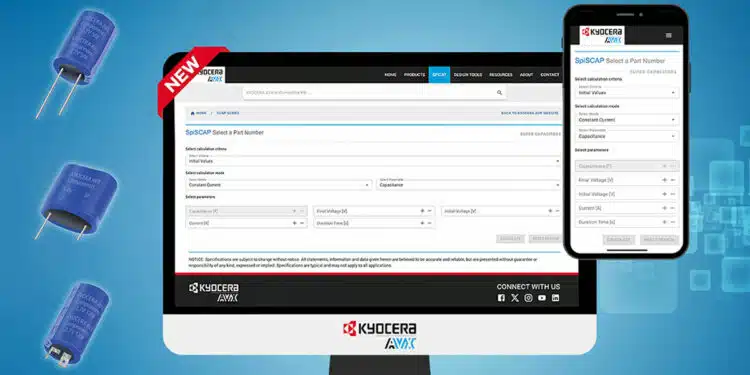KYOCERA AVX announced the new SpiCAT (SpiSCAP) online engineering simulation software that makes it easy for engineers to evaluate and select SCC and SCM Series supercapacitors.
The software is designed to overcome common power challenges in industrial, energy, automotive, transportation, telecommunications, commercial building, and consumer electronics applications.
KYOCERA AVX, a leading global manufacturer of advanced electronic components engineered to accelerate technological innovation and build a better future, released a new version of its SpiCAT online simulation software dedicated to supercapacitors.
SpiCAT online simulation software makes it easy for engineers to identify the unique characteristics of a wide variety of KYOCERA AVX components, including multilayer ceramic capacitors (MLCCs), polymer tantalum, and niobium capacitors, multilayer varistors (MLVs), negative-temperature-coefficient (NTC) thermistors, and — now — supercapacitors.
Supercapacitors are electrochemical double layer capacitors that strike a beneficial balance between the capabilities of electronic or dielectric capacitors (such as ceramic, tantalum, film, and aluminum electrolytic capacitors) and batteries — namely excellent pulse power handling characteristics resulting from the combination of very high capacitance and very low ESR. These unique large-energy-storage devices can be used by themselves or in conjunction with primary or secondary batteries to extend back-up time, lengthen battery life, and provide instantaneous power pulses in power backup, hold-up, energy harvesting, peak power assist, pulse power, and battery applications in the industrial, energy, telecommunications, automotive, transportation, and medical industries.
The new SpiCAT SpiSCAP online simulation software for KYOCERA AVX supercapacitors makes it easy for engineers to evaluate and select SCC and SCM Series supercapacitors optimized for their applications’ discharge requirements. Based on criteria including:
- Initial and end-of-life capacitance values, the latter of which is defined as exhibiting 70% of rated capacitance and 200% ESR
- Initial and final voltage
- Constant current, constant power, or constant resistance modes
- Power (W)
- Duration time
Users can identify recommended supercapacitor solutions ranging from single cells and modules to series and parallel combinations of parts and enjoy one-click access to detailed information about the proposed solutions, including physical and electrical characteristics, input values, part number explanations, and even interactive voltage and current vs. time graphs.
KYOCERA AVX supercapacitors, including SCC and SCM Series supercapacitors and supercapacitor modules, provide engineers with a number of practical advantages, such as:
- Capacitance values extending from 0.47F to 3,000F, depending on the series
- High pulse power and large energy storage capabilities
- Very low ESR and low leakage current ratings
- Reliable performance and long lifetimes when designed-in properly
- Support for series and parallel configurations capable of achieving custom working voltage and capacitance ratings
- Faster charge/discharge cycles, better performance over a wider range of rated operating temperatures (-40°C to +65°C at rated voltage or +85°C with appropriate derating), and superior cycle life compared to batteries
- The ability to extend primary and secondary battery lifetimes by a minimum of 2x on average
- The option of bent leads, custom wiring, connectors, and solder/weld terminals
- Rugged designs, including high-reliability, moisture-resistant models and automotive-grade options qualified to AEC-Q200
- Competitive pricing
- Favorable lead-times
- Manufacturing ownership and supply chain confidence
- Highly experienced engineering and technical support services
These unique characteristics also enable broad application suitability. KYOCERA AVX supercapacitors are ideal for emergency memory and power backup, battery supplement, peak power assist, and pulse power applications in
- Automation, robotics, and smart metering equipment
- Engine and motor starters
- Uninterruptible power supplies
- Wind turbines
- Mobile communications (GSM), radio (GPRS), telemetry, wireless alarm, emergency lighting, and hybrid systems
- Handheld controllers and scanners
- Electronic locks
- Wearables
“Supercapacitors, like our SCC and SCM Series, provide a number of unique advantages over both electric and dielectric capacitors and batteries and help engineers in the industrial, energy, automotive, transportation, telecommunications, commercial building, and consumer electronics markets overcome common power challenges. So, we’re very excited to release the new SpiCAT SpiSCAP online simulation software to help them evaluate and select supercapacitor solutions optimized for their unique application demands,” said Jiri Machanicek, Product Manager, KYOCERA AVX Components – Europe.































